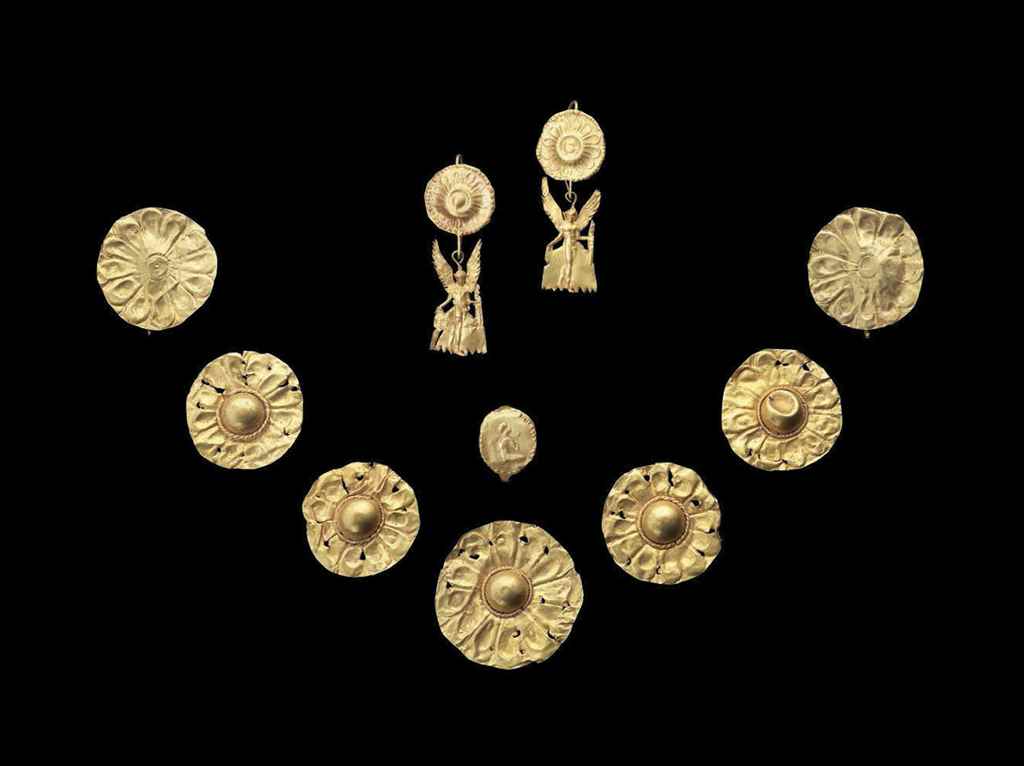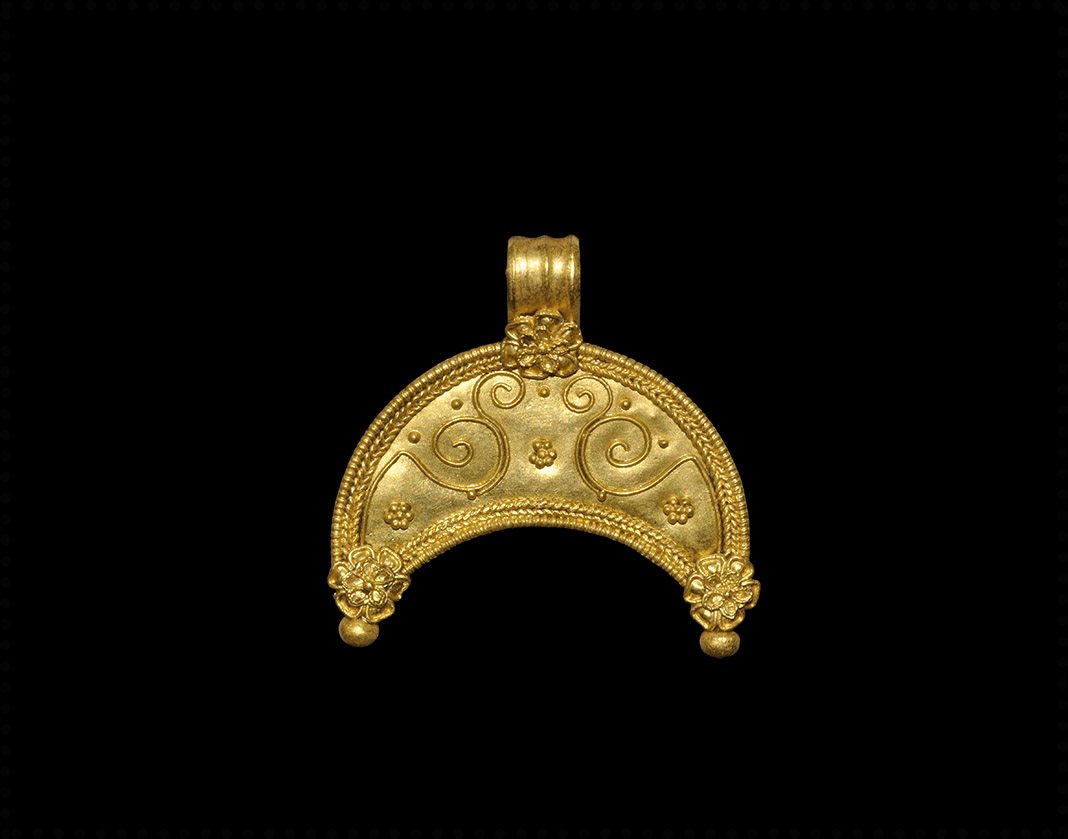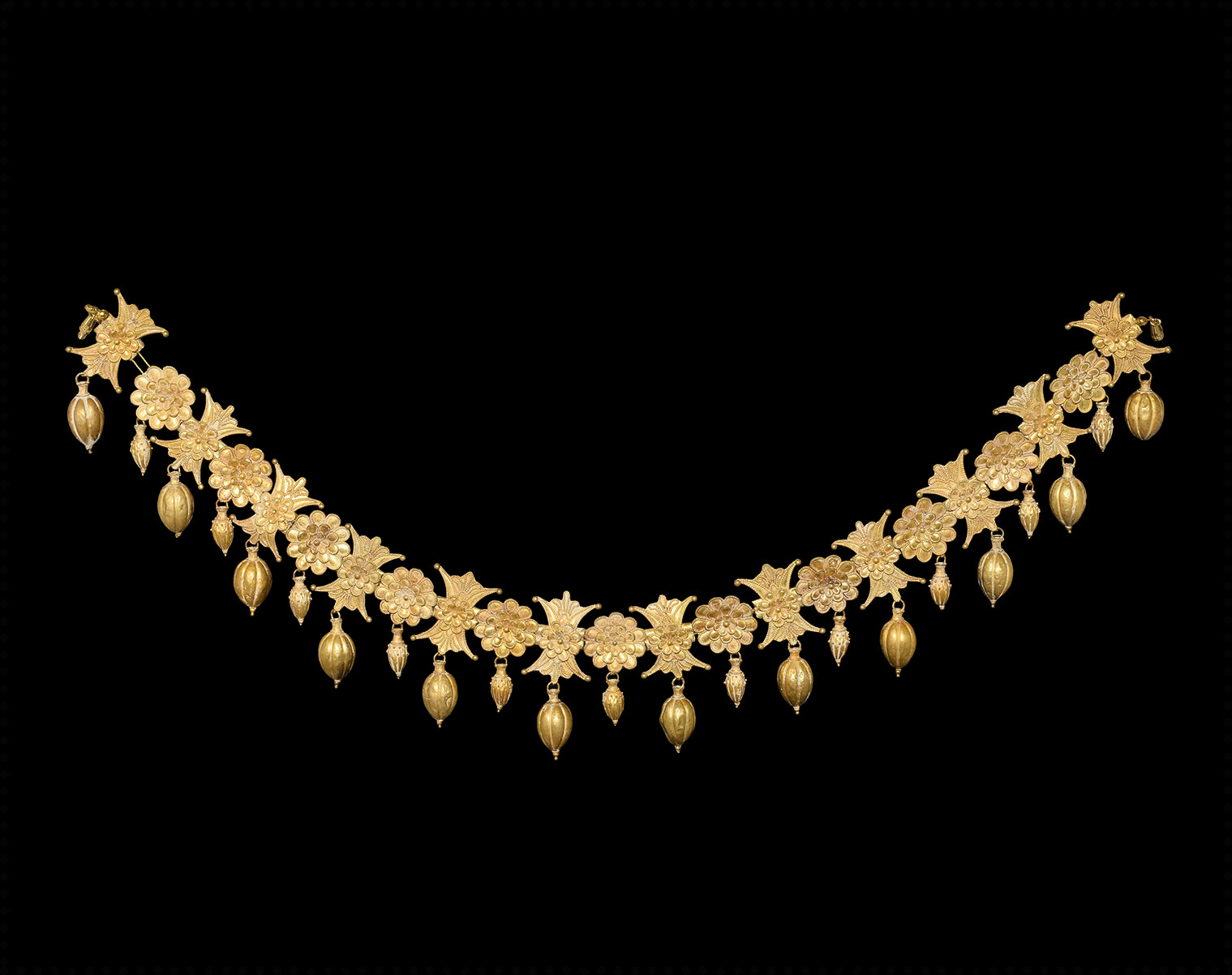GREEK GOLD ROSETTE AND PENDANT SET 4th century BC A restrung set of gold elements comprising: rosette plaques with beaded wire to the outer petals, hollow piriform vase pendants with filigree and granule detailing; pairs of lotus blossoms with beaded wire and granule detailing, hollow ribbed pendants with filigree loop and granule finial. 71 grams, 36cm (14 1/4"). Condition Very fine condition, some restoration. Provenance Ex an important American collection from Chicago, Illinois, USA; disposed of in 1995; previously in the Mansees collection; formed 1950s-early 1990s. Supplied with a positive X-Ray Fluorescence metal analysis certificate. Literature Cf. the Taranto necklace in Despini, A. Greek Art. Ancient Gold Jewellery, Athens, 1996, item 138-9. Footnotes Gold occurs rarely in Central Greece, but resources in Thrace, Asia Minor, Egypt and Spain were all exploited. Herodotus mentions Hyperborean sources, in the far north, which might indicate deposits in the Urals; he also writes of gold obtained by the Carthaginians who sailed beyond the Pillars of Herakles, known to us as the Straight of Gibraltar, to the Atlantic coast of Africa. Most famous in ancient literature is the gold of Asia Minor, where the mythical king Midas of Phrygia and the historical king Croesus of Lydia became synonymous with vast wealth. In Greece itself, Herodotus saw gold mines on the north Aegean island of Thasos, as well as the Cycladic island of Siphnos. The style of this necklace is in keeping with the tastes of the Eastern Greeks and the Hellenistic kingdoms. The pieces that come from the Black Sea region show the taste for gold, rendered beautifully by immigrant Greeks and local goldsmiths, was indulged in by both chieftains grown rich from the trading of grain, timber and other natural resources and Greek merchants and settlers, who may have adopted local customs. While some of their treasures are clearly the work of local craftsmen, others, like this piece, are highly refined works of unadulterated Greek style, suggesting that they were either imports or the products of Greek craftsmen who settled abroad in order to profit from serving wealthy foreign clients.
GREEK GOLD ROSETTE AND PENDANT SET 4th century BC A restrung set of gold elements comprising: rosette plaques with beaded wire to the outer petals, hollow piriform vase pendants with filigree and granule detailing; pairs of lotus blossoms with beaded wire and granule detailing, hollow ribbed pendants with filigree loop and granule finial. 71 grams, 36cm (14 1/4"). Condition Very fine condition, some restoration. Provenance Ex an important American collection from Chicago, Illinois, USA; disposed of in 1995; previously in the Mansees collection; formed 1950s-early 1990s. Supplied with a positive X-Ray Fluorescence metal analysis certificate. Literature Cf. the Taranto necklace in Despini, A. Greek Art. Ancient Gold Jewellery, Athens, 1996, item 138-9. Footnotes Gold occurs rarely in Central Greece, but resources in Thrace, Asia Minor, Egypt and Spain were all exploited. Herodotus mentions Hyperborean sources, in the far north, which might indicate deposits in the Urals; he also writes of gold obtained by the Carthaginians who sailed beyond the Pillars of Herakles, known to us as the Straight of Gibraltar, to the Atlantic coast of Africa. Most famous in ancient literature is the gold of Asia Minor, where the mythical king Midas of Phrygia and the historical king Croesus of Lydia became synonymous with vast wealth. In Greece itself, Herodotus saw gold mines on the north Aegean island of Thasos, as well as the Cycladic island of Siphnos. The style of this necklace is in keeping with the tastes of the Eastern Greeks and the Hellenistic kingdoms. The pieces that come from the Black Sea region show the taste for gold, rendered beautifully by immigrant Greeks and local goldsmiths, was indulged in by both chieftains grown rich from the trading of grain, timber and other natural resources and Greek merchants and settlers, who may have adopted local customs. While some of their treasures are clearly the work of local craftsmen, others, like this piece, are highly refined works of unadulterated Greek style, suggesting that they were either imports or the products of Greek craftsmen who settled abroad in order to profit from serving wealthy foreign clients.















Try LotSearch and its premium features for 7 days - without any costs!
Be notified automatically about new items in upcoming auctions.
Create an alert